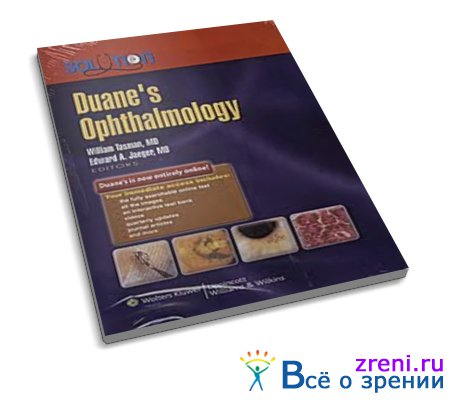Duane's Ophthalmology | William Tasman, Edward A Jaeger

Автор: William Tasman, Edward A Jaeger
Год: 2007
Издательство: Lippincott Williams & Wilkins
Формат: CHM
Качество: Электронная книга
Содержание статьи:
Описание
В этом классическом руководстве собрана обширная информация по последним хирургическим и терапевтическим методам лечения разнообразных офтальмологических заболеваний: первичной открытоугольной глаукомы, отслойки сетчатки, повышенного внутриглазного давления и др.
Данное руководство обеспечивает возможность получения фундаментальных знаний по всем разделам офтальмологии, начиная от подробных данных по анатомии и физиологии органа зрения и заканчивая новейшими сведениями о этиологии, патогенезе, клинике, диагностике и лечении глазных болезней.
Данный том представляет собой онлайн-копию одного из наиболее полных руководств по офтальмологии по состоянию на 2007 год.
The vast information stored in this classic reference is right at your fingertips with this fully searchable online version. This easy-to-navigate Website gives you instant access to the latest surgical techniques and treatments for primary open angle glaucoma, retinal detachment, ocular hypertension, and more. And you'll manage every eye problem, large and small, with confidence. In addition to quarterly updates to the core content of Duane's, the Website will add new videos, new test questions, and more throughout your entire two-year subscription. It's still the Duane's Ophthalmology you have trusted for over 30 years, but we are no longer providing you with a CD-ROM that can't be updated. With Duane's Ophthalmology being fully online, we can better serve your needs by providing you with the most up-to-date information every time you access the site.
↑ Disclaimer
Care has been taken to confirm the accuracy of the information presented and to describe generally accepted practices. However, the authors, editors, and publisher are not responsible for errors or omissions or for any consequences from application of the information in this book and make no warranty, expressed or implied, with respect to the contents of the publication.
The authors, editors, and publisher have exerted every effort to ensure that drug selection and dosage set forth in this text are in accordance with current recommendations and practice at the time of publication. However, in view of ongoing research, changes in government regulations, and the constant flow of information relating to drug therapy and drug reactions, the reader is urged to check the package insert for each drug for any change in indications and dosage and for added warnings and precautions. This is particularly important when the recommended agent is a new or infrequently employed drug.
Some drugs and medical devices presented in this publication have Food and Drug Administration (FDA) clearance for limited use in restricted research settings. It is the responsibility of the health care provider to ascertain the FDA status of each drug or device planned for use in their clinical practice.
[banner_centerrs] {banner_centerrs} [/banner_centerrs]
↑ Preface
Several years ago, when we were in the throes of the original planning stages for a practical series on ophthalmology, it seemed logical to present textbooks on the basic sciences first and have them serve as a foundation upon which a thorough and sound understanding of the clinical management of patients with visual disease would be based.
We altered this game plan for a couple of reasons. My great literary hero, Sir Stewart Duke-Elder, had for all intents and purposes reached the end of his prestigious, creative career, so there was a potential vacuum in the realm of up-to-date clinical ophthalmology texts. Presented with an opportunity to fill this void, we decided to begin our series on the clinical side. I would like to take this opportunity, however, to salute Sir Stewart and to announce that if the opportunity arises after I cross the great divide I would like to spend the first 10 years reading every word he ever wrote for publication. It has always distressed me that if our books caught on it would be at the expense of the greatest single author who ever took pen in hand to describe the eye and its relation to the world of science.
Also, although the publishers were of the opinion that because the basic sciences change so slowly in a field such as ophthalmology a few bound books were all that were needed, my limited experience in the laboratory and with such organizations as the Association for Research in Vision and Ophthalmology and the National Eye Institute had convinced me that new techniques and indeed entirely new technologies were turning over so fast in the basic foundation areas that the only way to even come close to keeping tabs on them would be with the loose-leaf methodology.
Of course, we have no intention of trying to keep up to date by adding and subtracting every new esoteric nuance that is presented in the basic fields. We are not a medical journal. Our goals, which have remained unaltered from the start, are to provide practitioners with an up-to-date, organized, systematic approach to the visual system. We want them to make diagnoses and to understand the etiology and pathogenesis of diseases so that they can institute therapy and adjust the management of the patient in an intelligent and informed fashion. It is true that this process presupposes a thorough knowledge of structure and function in health and disease, and it is this knowledge we now wish to provide, after these many years of delay, through Biomedical Foundations of Ophthalmology. After all, disease mechanisms may be considered to represent the human body's normal reactions to abnormal insults. It isn't just to enable the reader to pass the Boards that we designed Biomedical Foundations, although of course we are aware that many of our readers have that secondary goal hanging over their heads. Alas, there is even a movement for ?€?recertification?€ in ophthalmology, as has been adopted in some of the other disciplines. Although such a turn of events might sell more of our books, I am personally opposed to this development.
In any event, this whole series is designed with the practitioner in view. We are not presenting a handbook for the future researcher; these are available elsewhere (see the 5-year plans of the NEI). If clinical (or basic) ideas for experimentation occur to the reader, so much the better, and we wish him Godspeed.
However, first of all we want the reader to comprehend what is known?€”in the basic and clinical areas?€”before venturing into the unknown.
Some of my colleagues needle me and say that all I do is assemble the manuscripts, send them in, and sit back and await the praise and the royalties. My answer to that is as follows. For years in Philadelphia we have been proud of our orchestra. It has been essentially the product of one man, Eugene Ormandy, who years ago was a fair violinist but whose great forte has been the welding together of a diverse group of talented musicians who, combined, produce the ?€?Philadelphia sound.?€ Now each of these musicians is an expert. Each can play his instrument in a manner that could never be emulated by Ormandy. However, without the maestro it is conceivable that there would not be anything resembling the music that emanates from the Academy of Music in Philadelphia. I don't pretend to be an Ormandy (or a Riccardo Muti). But we do have much ophthalmic talent in this country and in the Western world, and the trick is to pull it all together to produce a publication that will be of help to both physicians and their patients. If we accomplish this, our goal will be attained.
As I stated in the preface to Clinical Ophthalmology, there may be some mistakes and omissions in these volumes. I am fully responsible for these, and I ask the astute reader to call them to my attention.
You will note that a Co?€“Chief Editor, Edward A. Jaeger, has been appointed. Ed is a private-practicing general ophthalmologist who has also devoted a great deal of time to medical education. He has spent untold hours providing didactic and one-on-one teaching to undergraduate students and residents. This dual role of clinical practitioner and academician provides a broad perspective for his editing responsibilities. Ed has been a Section Editor for Clinical Ophthalmology and has proven himself to be a stickler for editing details, yet at the same time he is able to keep the overall picture in perspective.
I have told all Section Editors to look for similar assistants if they have not already chosen one. These co-editors can provide help and objectivity; in time they may take over as Section Editors, and the transition will be smooth because they will be thoroughly familiar with the ropes.
Since Clinical Ophthalmology appeared there have been some changes. Harper and Row has acquired Lippincott, which is now the Medical Publishing Division of Harper and Row. This has brought together new individuals to work with the former Hagerstown group.
Rene L. Boudreau, the Medical Loose-leaf Editor, has been a tremendous help on a day-to-day basis. Edward B. Hutton, Jr., President of Lippincott, and Bruce Martin, Manuscript Editor, provide enthusiastic management and technical know-how respectively.
We will miss G. David Williams, the previous Medical Loose-leaf Editor, and David P. Miller, former Vice-President and Publisher of Harper and Row, without whom this entire work would never have seen the light of day. I once stated that Dave Miller had been like a father to me, which upset him because I am older chronologically, but he still has a more mature approach to publishing because of his years of experience.
So we are off and running again, and it is our hope that the readers will enjoy and be as stimulated by this new work as we have been. As stated before, if we save eyes, we can ask no more.
Thomas D. Duane M.D., Ph.D
Снимки (скриншоты) книги
Купить или скачать книгу
Все файлы на сайте, прежде чем выкладываются, проверяются на вирусы. Поэтому мы даем 100% гарантию чистоты файлов.






Комментариев 0